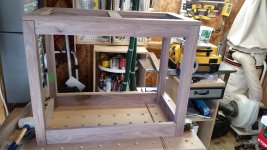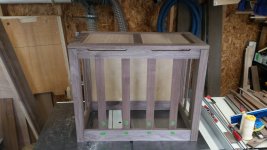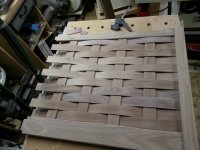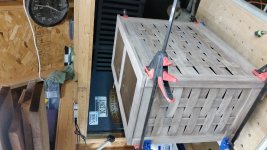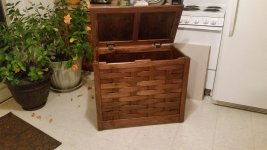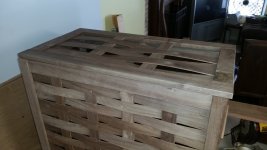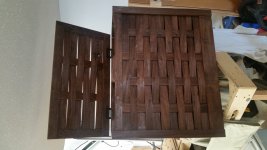Edward - the strips are 1/8" thick. I used a 3/16" bit to cut the receiving grooves in the corner posts where the woven slats are captured. Getting the slats to 1/8" took some trial and error. I initially tried cutting everything to about 3/16" thick and then passing them through the planer. I had mixed results with this. Some of the slats came through with no issue, others got sucked up into the cutterhead and destroyed. I then tried cutting them at the bandsaw (with a cleanup pass on the jointer in between each one) and this works well. There is a bit of sanding to do to remove the blade marks on one face of the slats, but since that side will be on the inside of the hamper you could elect to skip that step. If you choose to do a woven top like I did on the second version, I'd definitely sand both sides of the slats. I also tried cutting the slats on the tablesaw (again with a cleanup pass on the jointer in between each one) and although there is less yield due to the wider kerf this results in a smoother cut side and reduces sanding effort. I had just picked up a Forrest Woodworker II blade right before I did this and the results were quite impressive. I had to remove and clean the blade a few times to remove some buildup but that wasn't a huge issue.
I would cut all of the slats (whether for the front or sides) to the length of the front slats. Count on damaging a few of them (or more than a few in my case) when sanding/cutting/installing. I found that I could cut down some of the damaged ones and use them for the side slats. Additionally I was able to use the scrap slat cut off as clamping cauls to prevent damage on to the frame which was a convenient turn of events.
I put a very slight chamfer on the top and bottom edges on both faces of the slats prior to sanding and install. I felt like this would reduce damage to the slats over time, and hopefully prevent any injury to small fingers that decide to explore the hamper. This has proven to be true in both cases so far.
As far as the glue up goes, I followed Marc's plans and steps pretty much exactly on the first version. Putting on the second leg of the panels while trying to clamp the free ends of the slats was a huge pain in the ass no matter how I tried to do it. This actually contributed to some of the damaged slats and a good deal of harsh language on my part. On the second hamper, I happily discovered that I could completely assemble the carcass and do all of the weaving after. The slats are flexible enough at 1/8" to bend the end of them enough to slip them into the receiving grooves on the legs. This made the whole process much faster and far less frustrating. The better your sanding job is on the slats, the easier they will be to weave.
Have fun if you decide to build one. Hit me up with any questions - I must have watched the videos a couple hundred times each and while Marc's instruction is great, I found a couple procedural differences that worked a bit better for me.


